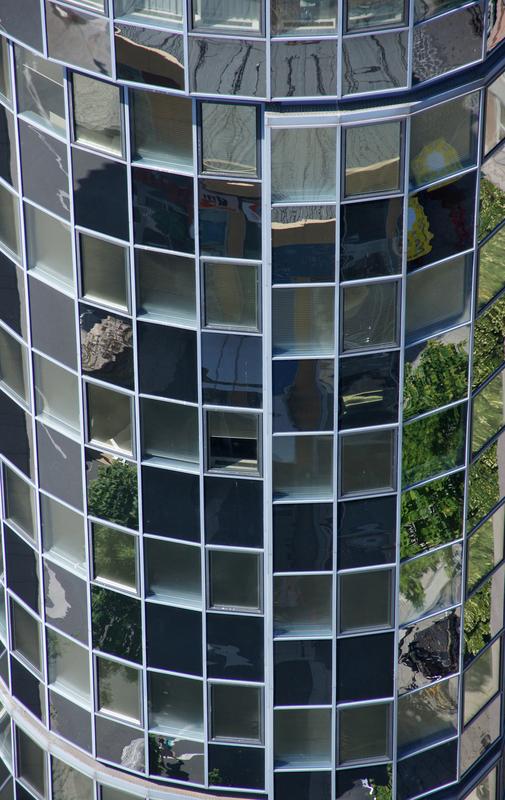Intelligent façades generating electricity, heat and algae biomass

The goals of the new project, that is coordinated by materials scientists of Jena University, are more intelligent façades. Photo: Jan-Peter Kasper/Univ. Jena
Windows that change their light permeability at the touch of a button, façades, whose color can be changed according to the sunlight, façades and window parts in which transparent photovoltaic modules are integrated or in which microalgae are being bred to provide the house with its own biofuel: This is what the buildings of the future could feature, or at least something similar.
“Many of these ideas are certainly within imagination end even technological feasibility, today, in particular within the field of façades which may adapt to their environment and thus improve the energy efficiency of modern buildings,” states Prof. Dr.-Ing. Lothar Wondraczek from Friedrich Schiller University in Jena (Germany). “But only a fraction of this potential has been tackled so far, as the relevant materials and production processes are still missing,” he further explains.
A new international research effort, coordinated by Jena’s materials scientist Lothar Wondraczek, is aiming to change this. In the project ‘Large-Area Fluidic Windows – LaWin’ the scientists intend to develop functional façades and window modules, together with an integrated production process to achieve an as to yet unmatched readiness to market.
“This requires close collaboration of architects, materials researchers, and civil and construction engineers. That is why we established a broad, interdisciplinary consortium.” All in all, 14 participants take part in the ‘LaWin‘.-project: Apart from the academic partners at Jena University, Weimar University, Beuth University of Applied Sciences, eleven industrial corporations from Germany, Austria, Belgium and the Czech Republic are involved.
Over the coming 3 years, the European Commission supports the project with about 6 Million Euro within the European framework program ‘Horizon 2020’. The partaking industrial partners will be adding another 2.1 Million Euro to that.
In Jena the project is located at the “Center for Energy and Environmental Chemistry” (CEEC). There, Prof. Wondraczek and his team will work on new glass modules for building façades, which consist of two joint glass layers: one layer made from a very thin and high strength cover glass and one layer of structured glass.
“This structured glass contains microfluidic channels through which a functional fluid circulates. As an example, this liquid will make it possible to automatically adjust the incidence of light or to harvest exterior heat which will then be transported to a heat pump,” Wondraczek explains. The scientists will conduct detailed tests of such façade and window modules to optimize the materials and their functional interaction.
Therefore, ‘LaWin‘ takes will take another step forward, i. e., to outside of the laboratory: Based on the results of their laboratory findings, the scientists plan to implement the innovative façades with reference buildings in order to test them under ‘real’ conditions. “The challenge lies in the large size”, Wondraczek points out.
“As of today, there is no production process for such large-sized glass sheet with integrated micro structures. Moreover, the new glass façades have to be able to be integrated into conventional window and façade systems.” They also have to be cost-effective. After all, a third of all greenhouse gas emissions in the EU and 40 percent of the energy consumption are due to the heating, cooling, air conditioning and lighting of buildings. Investments in energy efficient buildings are hence the most important levers to significantly reduce the carbon dioxide emissions and to reach the climate goals.
“This is given by the laws of thermodynamics: To save and to efficiently use energy is always more beneficial than to generate it from whichever source,” the Jena materials scientist stresses. The topical area of ‘energy efficient buildings’ is therefore one of eight strategic key areas in which the European commission‘s Public-Private-Partnership (PPP)-Initiative sees important possibilities for a sustainable reinforcement of the European innovation and industrial leadership in the global competition.
Contact:
Prof. Dr.-Ing. Lothar Wondraczek
Otto Schott Institute of Materials Research
Friedrich Schiller University of Jena
Fraunhoferstr. 6
07743 Jena
Germany
Phone: +049 (0)3641 948504
Email: lothar.wondraczek[at]uni-jena.de
Media Contact
All latest news from the category: Materials Sciences
Materials management deals with the research, development, manufacturing and processing of raw and industrial materials. Key aspects here are biological and medical issues, which play an increasingly important role in this field.
innovations-report offers in-depth articles related to the development and application of materials and the structure and properties of new materials.
Newest articles

NASA: Mystery of life’s handedness deepens
The mystery of why life uses molecules with specific orientations has deepened with a NASA-funded discovery that RNA — a key molecule thought to have potentially held the instructions for…

What are the effects of historic lithium mining on water quality?
Study reveals low levels of common contaminants but high levels of other elements in waters associated with an abandoned lithium mine. Lithium ore and mining waste from a historic lithium…

Quantum-inspired design boosts efficiency of heat-to-electricity conversion
Rice engineers take unconventional route to improving thermophotovoltaic systems. Researchers at Rice University have found a new way to improve a key element of thermophotovoltaic (TPV) systems, which convert heat…



